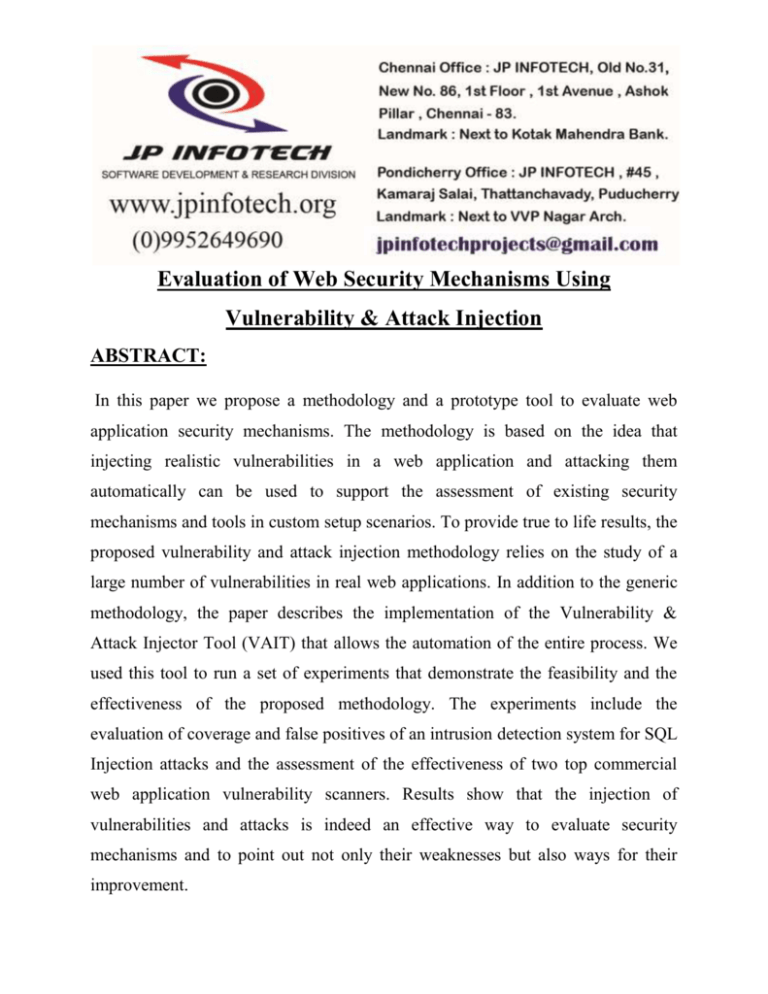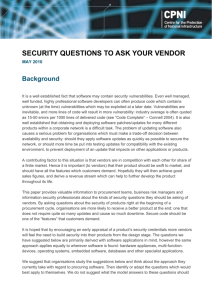Abstract
advertisement

Evaluation of Web Security Mechanisms Using Vulnerability & Attack Injection ABSTRACT: In this paper we propose a methodology and a prototype tool to evaluate web application security mechanisms. The methodology is based on the idea that injecting realistic vulnerabilities in a web application and attacking them automatically can be used to support the assessment of existing security mechanisms and tools in custom setup scenarios. To provide true to life results, the proposed vulnerability and attack injection methodology relies on the study of a large number of vulnerabilities in real web applications. In addition to the generic methodology, the paper describes the implementation of the Vulnerability & Attack Injector Tool (VAIT) that allows the automation of the entire process. We used this tool to run a set of experiments that demonstrate the feasibility and the effectiveness of the proposed methodology. The experiments include the evaluation of coverage and false positives of an intrusion detection system for SQL Injection attacks and the assessment of the effectiveness of two top commercial web application vulnerability scanners. Results show that the injection of vulnerabilities and attacks is indeed an effective way to evaluate security mechanisms and to point out not only their weaknesses but also ways for their improvement. EXISTING SYSTEM: To handle web application security, new tools need to be developed, and procedures and regulations must be improved, redesigned or invented. Moreover, everyone involved in the development process should be trained properly. All web applications should be thoroughly evaluated, verified and validated before going into production. However, these best practices are unfeasible to apply to the hundreds of millions of existing legacy web applications, so they should be constantly audited and protected by security tools during their lifetime. This is particularly relevant due to the extreme dynamicity of the security scenario, with new vulnerabilities and ways of exploitation being discovered every day. DISADVANTAGES OF EXISTING SYSTEM: Clearly, security technology is not good enough to stop web application attacks and practitioners should be concerned with the evaluation and the assurance of their success. In practice, there is a need for new ways to effectively test existing web application security mechanisms in order to evaluate and improve them. PROPOSED SYSTEM: The methodology proposed was implemented in a concrete Vulnerability & Attack Injector Tool (VAIT) for web applications. The tool was tested on top of widely used applications in two scenarios. The first to evaluate the effectiveness of the VAIT in generating a large number of realistic vulnerabilities for the offline assessment of security tools, in particular web application vulnerability scanners. The second to show how it can exploit injected vulnerabilities to launch attacks, allowing the online evaluation of the effectiveness of the counter measure mechanisms installed in the target system, in particular an intrusion detection system. ADVANTAGES OF PROPOSED SYSTEM: In practice, the use of both static and dynamic analysis is a key feature of the methodology that allows increasing the overall performance and effectiveness, as it provides the means to inject more vulnerability that can be successfully attacked and discarded those that cannot. The proposed methodology provides a practical environment that can be used to test countermeasure mechanisms (such as intrusion detection systems (IDSs), web application vulnerability scanners, web application fire-walls, static code analyzers, etc.), train and evaluate security teams, help estimate security measures (like the number of vulnerabilities present in the code), among others. This assessment of security tools can be done online by executing the attack injector while the security tool is also running; or offline by injecting a representative set of vulnerabilities that can be used as a testbed for evaluating a security tool. SYSTEM ARCHITECTURE: SYSTEM REQUIREMENTS: HARDWARE REQUIREMENTS: System : Pentium IV 2.4 GHz. Hard Disk : 40 GB. Floppy Drive : 1.44 Mb. Monitor : 15 VGA Colour. Mouse : Logitech. Ram : 512 Mb. SOFTWARE REQUIREMENTS: Operating system : Windows XP/7. Coding Language : JAVA/J2EE IDE : Netbeans 7.4 Database : MYSQL REFERENCE: Jose Fonseca, Marco Vieira, and Henrique Madeira “Evaluation of Web Security Mechanisms Using Vulnerability & Attack Injection”- IEEE TRANSACTIONS ON DEPENDABLE AND SECURE COMPUTING, VOL. 11, NO. 5, SEPTEMBER/OCTOBER 2014.











